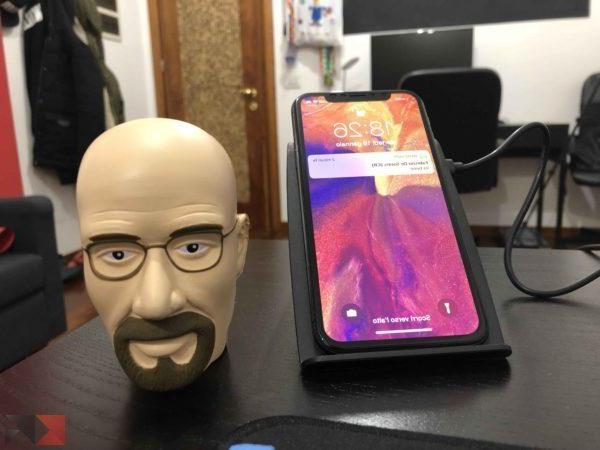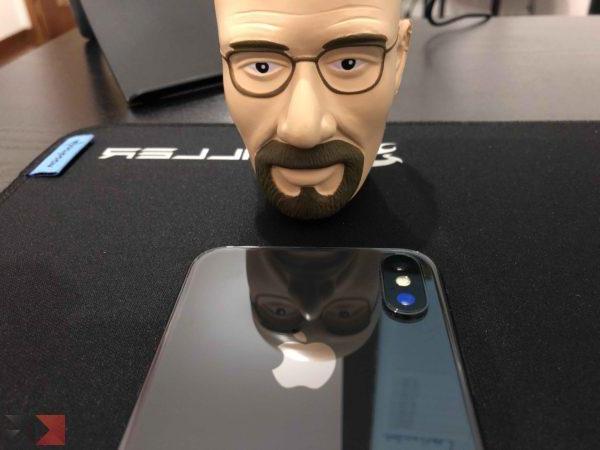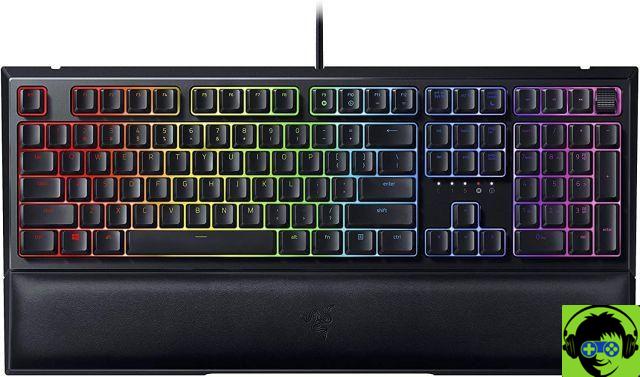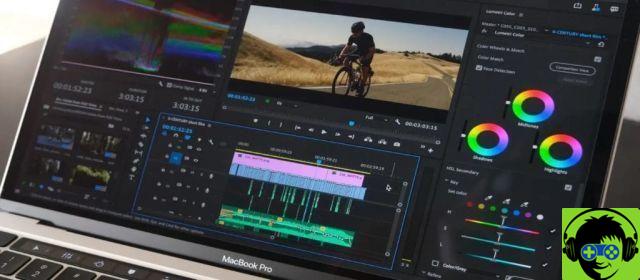When Apple unveiled iPhone X we were all surprised to see that along with it they were also announced iPhone 8 e 8 iPhone Plus. The surprise lies precisely in the fact that these two devices are the natural continuation of the classic design and well-established Apple standard, with all the necessary improvements, while iPhone X represents a real revolution.
Almost a "prototype" for someone: it is in fact the first smartphone borderless of the Cupertino company that has left quite a few perplexities from an aesthetic point of view but that inside, on the other hand, has power and quality to sell. The choice of an OLED screen instead of LCD is right, nothing to say from a photographic point of view which is really excellent (the rear camera is identical to that of the iPhone 8 Plus) and in everyday life there are no jamming or overheating problems.
Another revolution is represented by removal of the physical home button: iPhone X only has side keys to balance volume, power key and mute / ringer key. I gesti have replaced the classic habits and this at the beginning can scare a user: it is only a matter of practice but then we appreciate the gestures that Apple has introduced with iPhone X.
Another addition (more fun than anything else) of the iPhone X concerns the Animoji, which is a function that allows you to create talking emojis using the front camera of your iPhone. Also don't forget that iPhone X is IP67 certified and this means that it can withstand immersion in maximum 1 meter of (fresh) water for up to 30 minutes.
Face ID: the real revolution of iPhone X
The strong point and also the pivot of the iPhone X is undoubtedly the Face ID, or the facial recognition that has replaced Touch ID in all respects. After an initial phase of displacement, you will understand well how to use it to unlock the device. And it's fast! However, with Touch ID I was able to register multiple fingerprints (even those of family members or girlfriends) while Face ID is unique and there is no way to add multiple faces for unlocking.

How does it work? Well, really good: immediate release e awesome facial recognition that works in all conditions (backlit, in the dark, with little light, with a lot of light, with or without glasses, with or without hat, etc.). Apple's facial recognition technology is a step up (it has to be admitted) over anything else available on the market right now.
Just lift the iPhone X, look at the screen and the device is unlocked, and it's the same mechanism used to both unlock the phone and use apps. The biggest problem it will be if you are a person who leaves your iPhone on the desk and uses your thumb to check notifications: you will now have to lift the phone and look on the screen to view the updates (although from the iPhone X settings you can decide to show the contents of the notifications even when the smartphone is locked).
Another problem with Face ID compared to Touch ID is when using Apple Pay. Before you would have approached using your thumb on the Home button to immediately verify the payment, with the iPhone X you will have to double tap the side power button to activate Face ID, make it register your face and then you are ready to pay. Face ID is enabled by the TrueDepth front camera which is also used for the Portrait mode of selfies: however, we'll talk about this later.
Screen and design: conflicting opinions
The quality of the OLED display instead of LCD it is undeniable: the resolution of the display Super Retina su iPhone X it is technically sharper than that of the iPhone 8 Plus and iPhone 8. Furthermore, the blacks are perfect and the colors excellent. If as far as the screen is concerned both we and many other experts agree on the undisputed quality that Apple has provided to its iPhone X, the same cannot be said of the design of this new iPhone.
The design of the iPhone X is a mix of old and new. Very small bezel, a glass back and no home button but most of all that notch (or notch or lugs, call them whatever you want) which lead to a deep rift between the opinions of users and reviewers. There are those who appreciate them, personally speaking they have not impressed me and since there are borderless smartphones with the absence of the notch at the top, one wonders why Apple has decided not to do the same thing. Maybe to stand out? Maybe because the next iPhone of 2018 will no longer have the notch? We will find out.

Always on an aesthetic level, the rear camera protruding is something that has offended the sensitivity of many: I personally "solved" it using a protective cover that flattens everything and therefore I do not give it much weight.
In terms of how the iPhone X holds itself well, it's surprisingly easy to use one-handed (I recommend enabling one-handed use from General> Accessibility). It balances naturally in the hand, doesn't weigh much (174 grams well distributed) with the combination of glass and metal looking quite compelling.
One bad thing to say about design: Without a cover, the back often tends to capture fingerprints in the blink of an eye, and the front and back glass gladly accepts the oil your fingers want to deposit on them.
Performance and gestures: you will struggle at first
In three sentences we can enclose this paragraph: one of the most powerful phones in the world, very easy to use with one hand, some time to get used to the new gestures. Lacking the Home button, Apple had to introduce gestures to the iPhone X to replace what the center button used to offer. For example swiping up from the bottom of the screen no longer launches the Control Center but rather acts as a Home button.
Under the hood is a powerful engine: the A11 Bionic chip that works in tandem with 3GB of RAM. It doesn't feel like a lot of RAM when compared to Android devices but it's the most Apple has ever launched in a phone. And just enough to have excellent results and zero jamming.
Stunning cameras
Let's start with the novelty compared to iPhone 8 Plus: the 7.0 MP TrueDepth front camera which allows you to activate the Portrait mode, that is selfies where the background is blurred while your face in the foreground is in focus and in prominence. The shots are really great but remember that TrueDepth's depth sensing capabilities are limited to about a meter away - basically, face distance.
You can take advantage of the various scenes to have brighter photos, black and white, with a black background and more.

Now we come to the differences with the other iPhones: iPhone 8 doesn't have two rear cameras, while iPhone 8 Plus does and iPhone X too. phone that costs a lot of money and is Apple's top with the new A11 Bionic chip inside. Both of the iPhone X's rear cameras include optical image stabilization, while iPhone 8 Plus only has the main one with optical stabilization even though they basically have similar results.
Some of the shots on the iPhone X are amazing: low-light performance, when the light fades, is great, although the shutter speeds are slower and involve a greater touch of noise and blur.
La Portrait mode rear is one of the best on the market, but sometimes it does not perfectly find the edge of the objects it is trying to detect in depth: Google Pixel 2 it actually works best and with a single goal, although the results on both are sensational when everything works correctly.
As for some data, it should be noted that iPhone X can record videos up to 4K video at 24 fps, 30 fps or 60 fps with slow-motion video even in 1080p at 120 fps or 240 fps.
Battery: no miracle but reliable
The battery of the iPhone X is 2716mAh, a touch bigger than the iPhone 8 Plus which among the three new iPhones remains the one that guarantees the best autonomy (the iPhone X screen consumes the most). The battery life of the iPhone X is not mind blowing but you will arrive smoothly in the evening while it is impossible to start the second day on a single charge.
La fast charging of iPhone X and Wireless charging are two important innovations that deserve a mention
Conclusions
iPhone X is a late and successful evolution of the iPhone, as many other companies have already launched borderless smartphones, but you will have to leave your comfort zone to take the leap forward, recognizing the future. The price is the weak point: well 1.189€ for the 64 GB model of internal memory e 1.359€ for the 256 GB one (I recommend the lower cut one, if you have memory problems consult this suggestion). Here are some offers from Amazon:
[amazon_link asins=’B075LYDD7Z,B075LXNK24′ template=’CR-ProductCarousel’ store=’chimrevo-21′ marketplace=’IT’ link_id=’3f546ff7-f526-11e7-a74a-933c4948e6b0′]


























